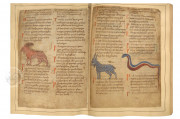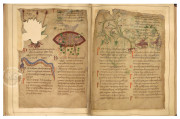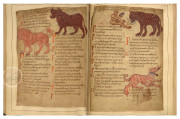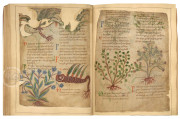The Old English Illustrated Pharmacopoeia is the only surviving illustrated manuscript of the Old English translation of a group of ancient texts on medical treatments using plants and animals. It was created in southern England, probably at Winchester or Canterbury, in the first quarter of the eleventh century. The plants and animals that provide substances for cures, as well as venomous snakes and insects that cause health problems, are pictured in 219 miniatures. Two full-page presentation miniatures, a chapter list, and a decorated incipit page open the text proper.
The manuscript is one of three surviving copies of an Old English text based on herbals attributed to the first-century BCE physician Antonius Musa and the second-century CE philosopher Apuleius; On Female Herbs, based on the herbal of the first-century CE Greek physician Dioscorides Pedanius; and a text on remedies derived from animal substances by the fourth-century Roman physician Sextus Placitus.
Roots, Leaves, and Berries
Presented with their root structures exposed, more than 100 plants are shown with their specific characteristics such as leaf shapes, fruits or berries, and flowers. Plants with distinctive features, such as the gladiolus and the mandrake, are readily identifiable (fols. 43v and 57v).
Animals from the Local Forest and Far Away
Among the quadrupeds pictured and the problems they address are the hare for oversleeping, the mountain goat for a nosebleed, the boar for sores, the lion for hallucinations, and the elephant for skin blemishes (fols. 77v, 78v, 80r, 81v, and 82r).
Picturing the Creature that Bit You
Pictures of snakes and insects whose bites can be poisonous are interspersed with the pictures of plants and four-footed animals that provide most of the healing substances. The image of sweet basil includes snakes because the plant was believed to grow in their habitat (fol. 57r).
Presentation in Two Columns
The text, written in English Vernacular Minuscule, is in two columns, and the column-width illustrations head each entry. The chapters on plants name the substance, describe the ailments for which it is efficacious, and provide instructions for preparing potions and salves from it. The entries for animals focus on patient complaints.
Used through the Ages
The Old English Illustrated Pharmacopoeia comprises a remarkable breadth of knowledge. Since ancient medicinal information was rarely dismissed as ineffective in pre-modern Europe, the manuscript remained in use throughout the Middle Ages, evidenced by numerous annotations in Latin, Anglo-Norman, and English added by various scribes through at least the fourteenth century.
Mysterious Early Owners
Richard Hollond and Elysabet Colmore wrote their names in the manuscript, he in the fifteenth or sixteenth century and she in the sixteenth. About them, we know nothing more. Nor do we know when Robert Cotton (1571-1631) acquired it.
Cotton had the pharmacopoeia bound with other texts. Cotton's manuscript collection, augmented by that of his son, was bequeathed to the British nation by his grandson, John Cotton (1621-1702), and formed one of the foundation collections of the British Museum library. It was transferred to the British Library in 1973.
We have 1 facsimile edition of the manuscript "Old English Illustrated Pharmacopoeia": Old English Illustrated Pharmacopoeia facsimile edition, published by Rosenkilde and Bagger, 1998
Request Info / Price





